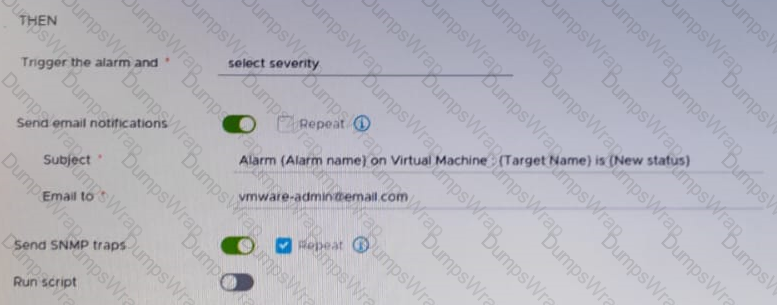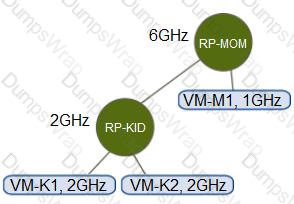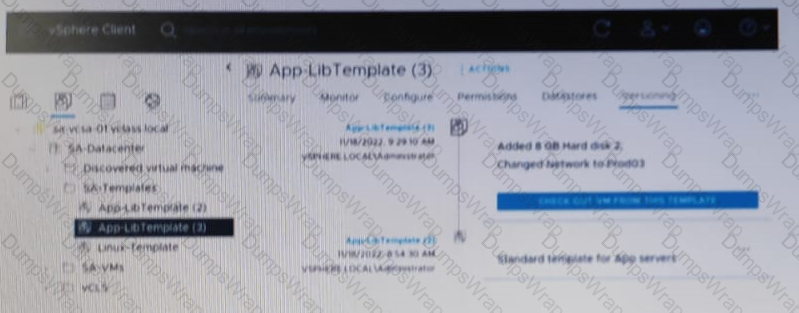VMware vSphere 8.x Professional Questions and Answers
An administrator is tasked with adding two additional hosts into an existing production vSphere cluster to support the need for additional capacity.
The vSphere cluster currently has four identically configured ESXi hosts (esxOT esx02. esx03 and esx04) that utilize Intel Skylake-based CPUs. The two new hosts (esx05 and esx06) are configured identically in terms of memory and storage to the existing hosts: but utilize Intel Ice Lake-based CPUs.
The administrator must ensure that:
•Any virtual machine migrates to any of the six ESXi hosts running in the cluster.
•There is no virtual machine downtime during the process of adding the new hosts.
Which step should the administrator take to meet these requirements?
An administrator is asked to configure a security policy at the port group level of a standard switch.
The following requirements must be met:
• The security policy must apply to all virtual machines on portgroup-1.
• All traffic must be forwarded, regardless of the destination.
An administrator has a host profile named Standard-Config. The administrator wants to change the other host profiles to use only the storage configuration settings that are defined in the Standard-Config host profile.
What should the administrator do to make this change?
Refer to the exhibit.

After removing an ESXi host from a cluster for maintenance, a number of virtual machines have encountered the warning seen in the exhibit. After re-adding the ESXi, the issue is resolved. Which step should the administrator take to move the triggered alarm to its normal state?
An administrator plans to bring VMware vCenter offline in order to perform hardware mainte-nance on the host where the vCenter Server Appliance is running.
Which vSphere feature must be configured to ensure that vCenter users experience minimal downtime?
An administrator is tasked with configuring certificates for a VMware software-defined data center (SDDC) based on the following requirements:
• All certificates should use certificates trusted by the Enterprise Certificate Authority (CA).
• The solution should minimize the ongoing management overhead of replacing certificates.
Which three actions should the administrator take to ensure that the solution meets corporate policy? (Choose three.)
A vSphere cluster has the following vSphere Distributed Resource Scheduler (DRS) group configuration:
* Virtual machine (VM) group named DB
* Host groups named PROD11 and PROD55
The administrator wants to force the VMs in the DB group to run on the hosts in the PROD11 group. However, if all the hosts in PROD55.
Which VM/Host rule must the administrator create to ensure that these requirements are met?
Refer to the exhibit.

After updating a predefined alarm on VMware vCenter, an administrator enables email notifications as shown in the attached alarm; however, notifications are NOT being sent.
Where must the mail server settings be configured by the administrator to resolve this issue?
An administrator is tasked with configuring vSphere Trust Authority. The administrator has completed the following steps:
• Set up the workstation
• Enabled the Trust Authority Administrator
• Enabled the Trust Authority State
• Collected information about the ESXi hosts and vCenter to be trusted
Which step does the administrator need to complete next?
An administrator is preparing for a deployment of a new vCenter Server Appliance. The following information has been provided to complete the deployment:
•ESXi Host name (FQDN): esxOl.corp local . ESXi IP Address: 172.20.10.200
•vCenter Server Name (FQDN): vcsa01 corp.local
•vCenter Server IP Address: 172.20 10.100
•NTP Server: 172.20.10.20
•DNS Server: 172.20.10.1
•Deployment Size: Tiny
•Storage Size: Default
Which two actions must the administrator complete before starting the installation of the vCenter Server Appliance? (Choose two.)
An administrator is responsible for the management of a VMware vCenter instance that is currently experiencing performance issues. The administrator quickly identifies that the CPU and memory utilization of vCenter is consistently over 80%. Upon further analysis, it seems that the vpxd process is contributing significantly to the performance issue.
A combination of which four steps should the administrator take to resolve the performance issues and ensure that a similar issue can be rectified without requiring downtime to vCenter moving forward? (Choose four.)
Refer to Exhibit:

An environment has the following configuration:
•Resource Pool “RP-MOM? has a reservation of 6GHz and one running virtual machine (VM) "VM-M1? with 1 GHz reserved
•Resource Pool ^RP-KID? has a reservation of 2GHz, and expandable reservations is activated
The administrator creates two VMs, “VM-K1? and 'VM-K2?, in the ''RP-KID? resource pool with 2GHz reserved for each, and turns on “VM-M1 ?
Given this scenario, which statement is true?
An administrator is tasked with looking into the disaster recovery (DR) options for a software-defined data center (SDDC).
The following requirements must be met:
•All virtual machines (VMs) must be protected to a secondary site.
•The source VMs must remain online until the failover.
•When failing over to the secondary site, application downtime is allowed
•The DR failover must be managed from the vSphere Client.
•Costs must remain as low as possible.
How can the administrator accomplish this task?
Refer to the exhibit.

Given the configuration shown in the exhibit, what must the administrator do to delete only the latest version of the template?
An administrator is tasked with moving an application and guest operating system (OS) running on top of a physical server to a software-defined data center (SDDC) in a remote secure location.
The following constraints apply:
• The remote secure location has no network connectivity to the outside world.
• The business owner is not concerned if all changes in the application make it to the SDDC in the secure location.
• The application's data is hosted in a database with a high number of transactions.
What could the administrator do to create an image of the guest OS and application that can be moved to this remote data center?
An administrator is attempting to configure Storage I/O Control (SIOC) on five datastores within a vSphere environment. The administrator is being asked to determine why SIOC configuration completed successfully on only four of the datastores.
What are two possible reasons why the configuration was not successful? (Choose two.)
An administrator creates a new corporate virtual machine (VM) template every month to include all of the latest patches. The administrator needs to ensure that the new VM template is synchronized from the primary data center site (London) to two secondary data center sites (Tokyo and New York). The administrator is aware that datastore space is limited within the secondary data center sites. The administrator needs to ensure that the VM template is available in the secondary sites the first time a new virtual machine is requested.
Which four steps should the administrator take to meet these requirements? (Choose four.)
administrator successfully installs VMware ESXi onto the first host of a new vSphere duster but makes no additional configuration changes. When attempting to log into the vSphere Host Client using the Fully Qualified Domain Name (FQDN) of the host, the administrator receives the following error message:
‘’server Not Found –we can’t connect to the server at esxit101.corp.local.’’
• Host FQDN: esxi 101. Corp. local
• Management VLAN ID: 10
• DHCP: No
• Management IP Address: 172.16.10.101/24
• Management IP Gateway: 172.16.10.1
• Corporate DNS Servers: 172.16.10.5, 172.16.10.6
• DNS Domain: corp.local
Which three high level tasks should the administrator complete, at a minimum, in order to successfully log into the
the vSphsrs Host Client using the FQDN for the exxi101 and complete the configuration (Choose three.)
After adding a new vSphere ESXi host with identical hardware configuration to an existing vSphere cluster, which task would an administrator complete prior to checking the compliance with an existing host profile?
An administrator is tasked with deploying a new on-premises software-defined data center (SDDC) that will contain a total of eight VMware vCenter instances.
The following requirements must be met:
• All vCenter instances should be visible in a single vSphere Client session.
• All vCenter inventory should be searchable from a single vSphere Client session.
• Any administrator must be able to complete operations on any vCenter instance using a single set of credentials.
What should the administrator configure to meet these requirements?
An administrator manages VM templates and ISO images for a remote office. Their main requirements are to store these templates in a single repository and manage different versions of the templates.
What solution should the administrator deploy to meet these requirements?
An administrator decides to restore VMware vCenter from a file-based backup following a failed upgrade. Which interface should the administrator use to complete the restore?
An administrator notices a performance issue in VMvvare vCenter To try and understand more about the performance issue, the administrator needs to gather more information about the vCenter database to eliminate a potential disk space issue.
Which two tools can the administrator use? (Choose two.)
An administrator wants to use tag-based placement rules on their virtual machine disks using VMware vCenter.
Which option would allow the administrator to achieve this?
What are two uses cases for VMware Tools? (Choose two.)
An administrator wants to create virtual machine (VM) templates and store them in a content library. The administrator would like to use the content library to manage different versions of these templates so that reverting to an earlier version is an option.
How should the administrator create these templates?
Which VMware offering will allow an administrator to manage the lifecycle of multiple vCenter Server instances in a single software as a service (SaaS)-based solution to help drive operational efficiency?
An administrator is working with VMware Support and Is asked to provide log bundles for the ESXI hosts in an environment. Which three options Joes the administrator have? (Choose three.)
An administrator is responsible for performing maintenance tasks on a vSphere cluster. The cluster has the following configuration:
. Identically configured vSphere ESXi hosts (esx01, esx02, esx03 and esx04)
• All workloads are deployed into a single VMFS datastore provided by the external storage array
• vSphere High Availability (HA) has not been enabled
• vSphere Distributed Resource Scheduler (DRS) has not been enabled
Currently, a critical production application workload (VM1) is running on esx01.
Given this scenario, which two actions are required to ensure VM1 continues to run when esx01 is placed into maintenance mode? (Choose two.)
An administrator must gracefully restart a virtual machine (VM) through the vSphere Client but the option is greyed out. The administrator has full administrative access on VMware vCenter and all the objects available in vCenter, but has no access to log onto the operating system.
Which action should the administrator take to meet the objective?
What are two use cases for VMware vSphere+? (Choose two.)
An administrator is investigating user logon failures for a VMware vCenter instance
Where can the administrator find log files containing information related to user login activities?

